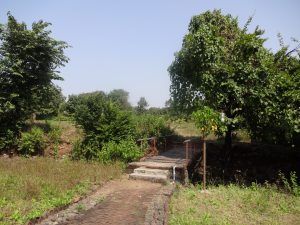
A ramp in the Krishivan property
While Krishivan is a simple farm that comes with no frills, it certainly is rich in its natural assets and oh so educative. To me, the place offered a total recall of my erstwhile science and geography class, which I oddly didn’t find as engaging at school.
The owner’s entrepreneurial approach to farming, chicken breeding/poultry, cow breeding and vegetable plantations is a thing to reckon.
Remember we completed a paddy harvesting tour in the last article on Krishivan? And then came back for a nap? Well, after an hour’s afternoon siesta in the hut we emerged all agog for the evening expedition on the farm.
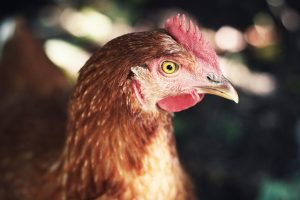
A hen from the poultry section
The first section we approached was the poultry section, a small area at the far end of the property. The poultry farm offers a source of revenue through its hens and eggs. The eggs are hatched in an incubator assembled by Sachin himself with help from his father. The chickens are sourced all the way from Phalton in the district of Satara. At a price of Rs 25 per bird, the monthly purchase is around 3,000 birds which, in turn, are used for local distribution. This makes Sachin a kind of a distributor, one who grows and breeds the birds as well. Several local farmers, therefore, approach him for 50 to 100 birds each and are sold at a profit. Quite a business eh.
 As we approached the pen where the chicks are bred we held our nose to stave off the strong smell wafting from the area. I caught a chick off guard and let it sit all aflutter over the top of my head. Chicks don’t fly per se but this particular chick may have found the seat of my head unpleasant and quickly fluttered over to the ground. It sped away like the sky was falling. Remember the story of the chicken and the sky?
As we approached the pen where the chicks are bred we held our nose to stave off the strong smell wafting from the area. I caught a chick off guard and let it sit all aflutter over the top of my head. Chicks don’t fly per se but this particular chick may have found the seat of my head unpleasant and quickly fluttered over to the ground. It sped away like the sky was falling. Remember the story of the chicken and the sky?
We were in a hurry to move on, chiefly to steer clear of the stinky area. We walked rapidly until we reached a section where big hens and fowls were bred, for sale. There was relatively less of a strong niff here so we breathed easier. The big birds were scheduled for a training session. A training session for hens! Really?! Well yes, there were pipe-like stands erected to allow the birds to perch upon after dark, disciplined to roost in place after feeding. Some training, I say!
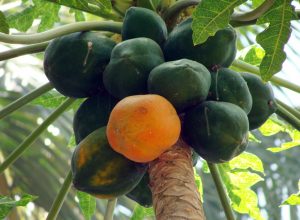
A papaya tree on the farm
The birds are fed by the local farm hands, quite often with drumsticks and papaya. Ripened papaya, say 100 grams of it, is adequate to provide a single bird with its nutritional requirement for a day. What mathematical calculations go into poultry farming as well! Having noticed some cashew nut shells, we learnt that they serve as “good protein” which goes into poultry feed. Such feed is sold @ Rs 300-400 per kilo. Amazing how every part of a vegetable or fruit, even its waste product is put to use.
The same guide took me on a tractor ride across a part of the property. At first, I waved at the goats and goatherds but then soon got bored. Riding in a tractor was less thrilling than driving one. Must aim to drive the tractor on my next visit if they will allow me that is. The tractor driver is known to be an all-rounder with the significant roles on the farm being handled by him. If not hands-on, he oversees outsourced labour for paddy harvesting.
Having had enough of smelly areas in a day, I was only glad to get a reprieve in the form of the reservoir on the property. The reservoir was but a large pond, 4 metres deep and a capacity to contain one crore litres of rainwater when full. Despite poor rainfall in the previous year, the reservoir was filled to half its depth. The water from the pond, I understood, was not used for irrigation as the Konkan monsoons easily fulfilled that need. The pond was chiefly used as a water bank that lasts until the summer.

The pond lined with high-density plastic
Fish were starting to be bred in October of the previous year and may have grown big enough and ready for fishing by the time this blog post is published. As the pond had an outlet for the water there was a risk of the fish escaping with its flow. Hence a mesh-like sheet was created to allow for only the water to flow through it but not the fish. Great idea!
Want to know how the pond was built? You’d be surprised at how the owner circumvented a technique to avoid the use of heavy-duty equipment in doing so. He adroitly utilised that section of the property which had a natural incline from which it was easy to scrape off the mud to shovel it on the other side. The benefit was two-fold in that there was no need to excavate a crore’s worth of mud. Besides, the mud that was scraped off didn’t go to waste but was used instead to create a bank on the opposite side. This saved on the cost of dredging equipment as well as on the cost of hiring trucks to carry the mud outside the property. Quite a money-saving project!
Another novel idea was to line the pond with high-density polyethene plastic to avoid the water seeping into the soil. The plastic is ultraviolet stabilised and thus does not get hard or crack with extreme sunlight or heat.
To show us the existence of fish, he let us have a try at throwing fish feed into the pond. As it was a wee bit too dark to see from that height, we weren’t able to see the tiny fish reach up to the surface in search of the feed, but I believe they would’ve been there. I was surprised to learn that cooked rice and papads were used as feed. Why papads, I wondered. Because they are roasted, non-oily, soak in water and ultimately is a form of rice! Whoa, novel again!
This brought us to the end of a long evening at the farm. More on what we saw of Krishivan’s vegetation will follow in the fourth blog post.
In the footer is a link to the farm’s website which will tell you all that you need to know in terms of its features so as to allow me to dwell solely on its finer attributes.


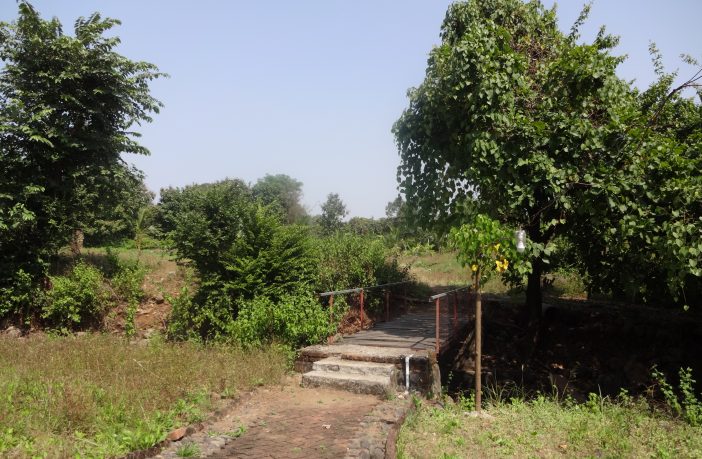
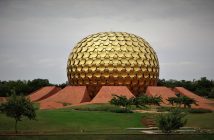
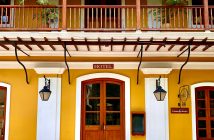
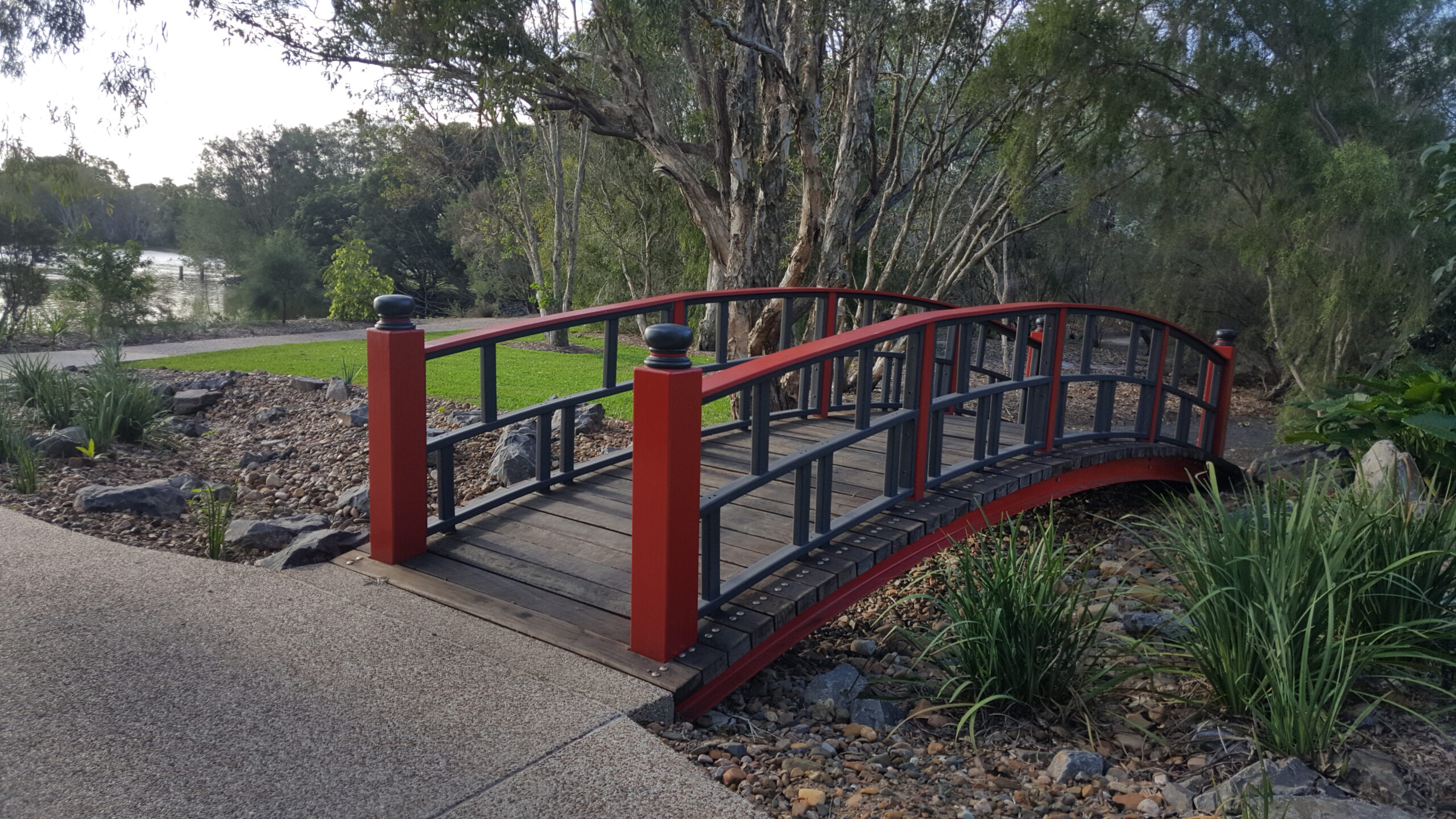
2 Comments
Makes interesting reading. Living off and with the land.
Yes, it is nature at its best.